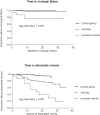Residual viremia is preceding viral blips and persistent low-level viremia in treated HIV-1 patients
- PMID: 25354368
- PMCID: PMC4212971
- DOI: 10.1371/journal.pone.0110749
Residual viremia is preceding viral blips and persistent low-level viremia in treated HIV-1 patients
Abstract
Background: It has been suggested that low-level viremia or blips in HIV-infected patients on antiretroviral treatment are related to assay variation and/or increased sensitivity of new commercial assays. The 50-copy cut-off for virologic failure is, therefore, under debate.
Methods: Treated patients with low-level viremia (persistent viral loads (VL) of 50-1000 copies/mL, group A, N = 16) or a blip (single detectable VL, group B, N = 77) were compared to a control group (consistently suppressed viremia since start therapy (<50 copies/mL), N = 79). Residual viremia (detectable viral RNA <50 copies/ml) in the year preceding the first VL above 50 copies/mL (T0) was determined using Roche Cobas-Amplicor v1.5 or CAP-CTM v2.0. Subsequent virologic failure (2 consecutive VLs>500 or 1 VL>1000 copies/mL that was not followed by a VL<50 copies/mL; median follow up 34 months) was assessed.
Results: Significantly more patients in groups A and B had residual viremia in the year preceding T0 compared to controls (50% and 19% vs 3% respectively; p<0.001). Residual viremia was associated with development of low-level viremia or blips (OR 10.9 (95% CI 2.9-40.6)). Subsequent virologic failure was seen more often in group A (3/16) and B (2/77) than in the control group (0/79).
Conclusion: Residual viremia is associated with development of blips and low-level viremia. Virologic failure occurred more often in patients with low-level viremia. These results suggest that low-level viremia results from viral production/replication rather than only assay variation.
Conflict of interest statement
Figures




References
-
- Thompson MA, Aberg JA, Hoy JF, Telenti A, Benson C, et al. (2012) Antiretroviral treatment of adult HIV infection: 2012 recommendations of the International Antiviral Society-USA panel. Jama 308: 387–402. - PubMed
-
- European AIDS Clinical Society (2013) EACS Guidelines.
-
- Doyle T, Smith C, Vitiello P, Cambiano V, Johnson M, et al. (2012) Plasma HIV-1 RNA detection below 50 copies/ml and risk of virologic rebound in patients receiving highly active antiretroviral therapy. Clin Infect Dis 54: 724–732. - PubMed
Publication types
MeSH terms
Substances
LinkOut - more resources
Full Text Sources
Other Literature Sources
Medical
Molecular Biology Databases
Miscellaneous

